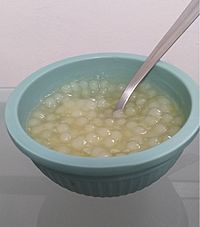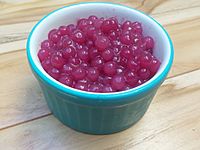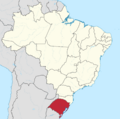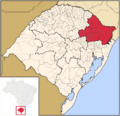Sagu (dessert) facts for kids
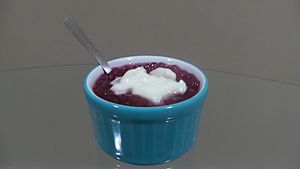
Sagu de vinho served in a ramekin, with a white cream on top of it.
|
|
| Alternative names | Sagu de vinho |
|---|---|
| Course | Dessert |
| Place of origin | Southern Brazil |
| Serving temperature | Warm, cold or at room temperature |
| Main ingredients | Tapioca balls and red wine |
Sagu (also called sagu de vinho) is a yummy dessert from southern Brazil. It's made with small, clear balls called tapioca pearls, sugar, and red wine. This dessert is very popular in the state of Rio Grande do Sul. You can also find it in Santa Catarina and Paraná.
Tapioca pearls first came to Latin America from Southeast Asia. They were brought by Spanish and Portuguese explorers. In Brazil, these pearls are still called sagu. But here, they are made from a plant called cassava, which grows in South America. They are not made from the sago palm tree, which is found in Asia.
The most common way to make this dessert is called sagu de vinho, which means "wine sago." It was first made in a region called Serra Gaúcha in Rio Grande do Sul. People usually mix the tapioca pearls with sugar and red wine. It can be served warm or cold. Often, a creamy sauce called crème anglaise is poured on top. Sometimes, people use beaten egg whites with sugar instead of cream.
Some recipes mix wine with grape juice. This makes the dessert sweeter and less strong. People also like to add cinnamon and cloves to the wine for extra flavor. While you can make tapioca pearls at home, most people buy them from a store.
Even though sagu de vinho is the most popular, tapioca pearls can also be cooked with milk or fruit juice. Orange or pineapple juice are sometimes used, especially by families with German backgrounds. But these versions are not as common as the red wine one.
Contents
History of Sagu
The word sagu comes from the Malay language. It originally meant starch taken from sago palm trees in Southeast Asia. This starch was often made into sago pearls for cooking. Later, the cassava plant, which is native to South America, was brought to Southeast Asia. It became another way to make pearls. So, the name "sagu" or "sago" started to be used for pearls made from cassava, potato, or sago starch.
When European immigrants came to Brazil, they brought the idea of making tapioca balls. These pearls became known as sagu in Brazil, even though they were made from local cassava starch. Long ago, the indigenous peoples in Brazil already knew how to chop and cook cassava roots for food.
In the early 1800s, when the Portuguese royal family moved to Brazil, cassava flour began to be mixed with Port wine. This created a sweet, thick dish, like an early version of sagu de vinho. Later, in the 1900s, small companies in southern Brazil, started by European families, began making cassava starch. This was an alternative to European starches like potato starch. By the 1940s, 1950s, and 1960s, companies in Santa Catarina and Rio Grande do Sul were making tapioca pearls from cassava. These pearls were then used in this popular dessert.
Some traditional German recipes, like rote grütze, are similar to sagu. They mix starch with red fruits. Even though sagu de vinho wasn't brought to Brazil by European immigrants, it became a symbol of European settlement. This dessert shows how Italian and German traditions mixed with Brazilian ingredients. Cassava, a native Brazilian plant, was combined with Italian red wine.
Different immigrant families sometimes make sagu in their own ways. German families might make it with milk, wine, or fruits like orange or pineapple. Italian families usually stick to making it only with red wine.
The Serra Gaúcha region, where sagu de vinho was created, was settled by people from northern Italy (especially Veneto) and Germany. Other European immigrants also came there. This dessert is mostly popular in Rio Grande do Sul. You might find it in Santa Catarina and Paraná, but it's almost unknown in other parts of Brazil or nearby countries like Argentina and Uruguay.
Taste and Characteristics
This dessert is not super sweet. Because of this, adults often like it more than children. In southern Brazil, people tend to prefer desserts that are less sweet, which helps explain why sagu is so popular there.
People describe sagu as a "sweet caviar." It has many small purple balls. It has a strong but gentle flavor. This recipe is quite easy to make, and its smell is very unique.
How to Prepare Sagu
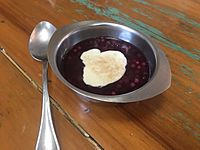
First, the cassava root is cleaned, grated, and mixed with water. Then, it's pushed through a special screen to make small balls. These balls are heated and then cooled, which makes them hard and cloudy.
To make the dessert, the tapioca pearls are usually soaked in water for a whole day. After soaking, the water is drained. Then, red wine, milk, or fruit juice is boiled. Water, cloves, and cinnamon are added to this mixture. When it boils again, the sagu pearls are added. You need to stir it all the time so it doesn't stick to the bottom of the pot. Finally, sugar is added, and you keep stirring until it reaches the thickness you want. It can be smoother or harder, more liquid or more solid.
You can serve sagu warm, cold, or at room temperature.
Nutritional Information
Tapioca pearls have a lot of calories because they are mostly starch. This makes them a good source of energy for your body. They also contain dietary fiber, iron, calcium, and a small amount of proteins.
Images for kids
See also
 In Spanish: Sagu (postre) para niños
In Spanish: Sagu (postre) para niños


